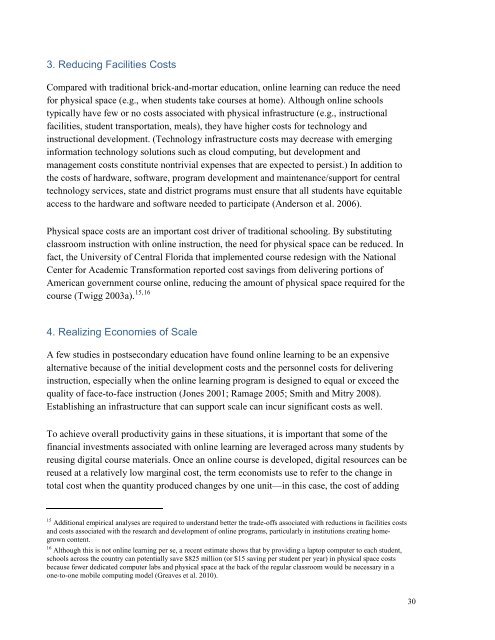Download PDF - SRI International
Download PDF - SRI International
Download PDF - SRI International
You also want an ePaper? Increase the reach of your titles
YUMPU automatically turns print PDFs into web optimized ePapers that Google loves.
3. Reducing Facilities Costs<br />
Compared with traditional brick-and-mortar education, online learning can reduce the need<br />
for physical space (e.g., when students take courses at home). Although online schools<br />
typically have few or no costs associated with physical infrastructure (e.g., instructional<br />
facilities, student transportation, meals), they have higher costs for technology and<br />
instructional development. (Technology infrastructure costs may decrease with emerging<br />
information technology solutions such as cloud computing, but development and<br />
management costs constitute nontrivial expenses that are expected to persist.) In addition to<br />
the costs of hardware, software, program development and maintenance/support for central<br />
technology services, state and district programs must ensure that all students have equitable<br />
access to the hardware and software needed to participate (Anderson et al. 2006).<br />
Physical space costs are an important cost driver of traditional schooling. By substituting<br />
classroom instruction with online instruction, the need for physical space can be reduced. In<br />
fact, the University of Central Florida that implemented course redesign with the National<br />
Center for Academic Transformation reported cost savings from delivering portions of<br />
American government course online, reducing the amount of physical space required for the<br />
course (Twigg 2003a). 15,16<br />
4. Realizing Economies of Scale<br />
A few studies in postsecondary education have found online learning to be an expensive<br />
alternative because of the initial development costs and the personnel costs for delivering<br />
instruction, especially when the online learning program is designed to equal or exceed the<br />
quality of face-to-face instruction (Jones 2001; Ramage 2005; Smith and Mitry 2008).<br />
Establishing an infrastructure that can support scale can incur significant costs as well.<br />
To achieve overall productivity gains in these situations, it is important that some of the<br />
financial investments associated with online learning are leveraged across many students by<br />
reusing digital course materials. Once an online course is developed, digital resources can be<br />
reused at a relatively low marginal cost, the term economists use to refer to the change in<br />
total cost when the quantity produced changes by one unit—in this case, the cost of adding<br />
15 Additional empirical analyses are required to understand better the trade-offs associated with reductions in facilities costs<br />
and costs associated with the research and development of online programs, particularly in institutions creating homegrown<br />
content.<br />
16 Although this is not online learning per se, a recent estimate shows that by providing a laptop computer to each student,<br />
schools across the country can potentially save $825 million (or $15 saving per student per year) in physical space costs<br />
because fewer dedicated computer labs and physical space at the back of the regular classroom would be necessary in a<br />
one-to-one mobile computing model (Greaves et al. 2010).<br />
30
















